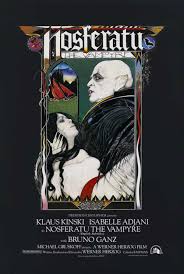Renfield (Roland Topor) is a real estate agent in Wismar, Germany in the 1800’s. He sends his employee, Jonathan Harker (Bruno Ganz) to Transylvania to close a deal with Count Dracula, who is interested in buying a large but dilapidated piece of property. Harker sets out on horseback leaving his wife, Lucy (Isabelle Adjani), at home.
Harker stops on the way at an inn near the Count’s castle. The local villagers try to tell him to stay away from the castle, but Harker ignores their warnings. Count Dracula (Klaus Kinski) turns out to be a pasty, bald man with pointed teeth and claw-like fingernails. Dracula becomes fascinated with a tiny portrait of Lucy that Harker carries with him. Both Harker and Lucy begin having nightmares. Harker, on the verge of insanity, is abandoned at the castle by Dracula. Dracula sends six coffins filled with dirt to Wismar aboard a ship. In one of the caskets Dracula sleeps. Harker escapes the castle but is injured. Before he fully recovers, he returns to Wismar. By the time he returns, however, he has become insane and doesn’t recognize Lucy.
On board the ship Dracula works his way through the crew draining their blood. By the time the ship drifts into Wismar harbor, the only one on board is the captain, who is dead and strapped to the ship’s wheel. Dracula waits in his coffin, waiting for nightfall so he can move his coffins to a secure hiding place. Also on board the derelict are rats infected by plague. The rats abandon the ship and swarm over the city, infecting the citizens. Dracula feasts on the people of Wismar as plague sweeps over the land. Dracula’s fascination for Lucy grows. Lucy learns what Dracula is by reading her husband’s diary. Lucy is unable to convince anyone in the village that Dracula is a worse danger than the plague. Lucy understands what she must sacrifice to rid the world of Dracula’s evil.
“Nosferatu the Vampyre” was released in 1979 and was directed by Werner Herzog. It is a French and West German gothic horror film. The film was done in both English and German. Some really nice cinematography combined with a great music score adds some interesting texture to the film. It is a slightly stylized version of the story and rather artistic. The film ended up being a lot more interesting than I expected. The editing is a little unusual in that it acts like each scene is a tiny portrait. The staging of each scene adds a degree of atmosphere adding a nuance of artistic flare to the film.
Director Herzog wanted the character of Dracula to appear subdued and eerie. This is something that the normally manic Kinski had a hard time with. To get the desired emotions Herzog would irritate Kinski to the point where he would, in essence, have a temper tantrum. This would exhaust Kinski to the point where his performance would be toned down enough to please Herzog. Supposedly Herzog quipped that the rats behaved better than Mr. Kinski. Kinski’s makeup was very much like the effect achieved with Max Schreck in the original silent version done by F.W. Murnau and took over three hours a day to achieve.
One interesting little item is that Dracula’s image can’t be seen in a mirror, but his shadow can. The scenes of the bat flying in slow motion were stock footage from a scientific documentary. The scenes during the opening credits were filmed at the “Mummies of Guanajuato Museum” in Mexico. Director Herzog has a cameo as the man who sticks his foot into one of Dracula’s coffins aboard ship and is bitten by a rat.
Rats dominate several scenes. The film required thousands of rats for several scenes. Since the filmmakers could only find white rats, Herzog had them dyed. Somewhere around 11,000 rats were dyed grey. The procedure killed many of them. A lot of rats also died on the trip from the research facility to the set leading animal rights activists to complain about their inhumane treatment.


